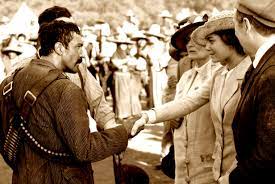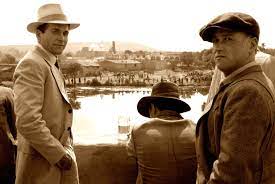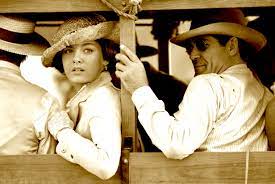🎬 And Starring Pancho Villa as Himself (2003)

And Starring Pancho Villa as Himself (2003) Review: A Fascinating Blend of History, Politics, and Cinema
Directed by Bruce Beresford, And Starring Pancho Villa as Himself is a unique historical drama that explores the intersection of revolution and early Hollywood. With Antonio Banderas delivering a charismatic performance as the legendary Mexican revolutionary Pancho Villa, the film delves into the complexities of Villa’s character and his unconventional collaboration with American filmmakers to fund his rebellion. Equal parts biographical drama and a commentary on the power of cinema, this HBO production offers an engaging and thought-provoking take on a lesser-known historical episode.
Plot Overview: Revolution Meets Hollywood
Set during the Mexican Revolution in 1914, the film tells the true story of Pancho Villa’s surprising partnership with the Mutual Film Corporation, a Hollywood studio that agrees to film Villa’s battles in exchange for exclusive rights to his story.
Villa, played by Antonio Banderas, uses the project to finance his rebellion against the Mexican government. At the same time, Frank Thayer (Eion Bailey), an idealistic young filmmaker, is tasked with documenting Villa’s exploits for the silver screen.
As the line between reality and staged drama blurs, Thayer becomes deeply immersed in Villa’s world, witnessing the charisma, brutality, and contradictions that define the revolutionary leader. The collaboration ultimately leads to a moral reckoning as Thayer grapples with the ethics of using real lives and deaths for entertainment.
Antonio Banderas as Pancho Villa: A Magnetic and Complex Performance
Antonio Banderas delivers a dynamic and layered portrayal of Pancho Villa, capturing both his larger-than-life charisma and his human flaws. Villa is depicted as a man of contradictions—charming yet ruthless, idealistic yet pragmatic—and Banderas masterfully conveys these complexities. His ability to shift seamlessly between moments of humor, passion, and menace makes his performance one of the film’s standout elements.
Eion Bailey as Frank Thayer: The Audience’s Perspective
Eion Bailey provides a compelling performance as Frank Thayer, a wide-eyed filmmaker who serves as the audience’s surrogate. Through Thayer’s eyes, viewers are introduced to the chaotic and morally ambiguous world of Villa’s revolution. Bailey’s portrayal captures Thayer’s idealism and gradual disillusionment, adding an emotional layer to the film.
Supporting Cast: A Rich Ensemble
- Alan Arkin as Sam Drebben: Arkin brings wit and grit to the role of Drebben, an experienced mercenary who works closely with Villa.
- Jim Broadbent as D.W. Griffith: Broadbent’s cameo as the legendary filmmaker adds a touch of cinematic history to the story.
- Kyle Chandler as Raoul Walsh: Chandler portrays the young Hollywood director who works alongside Thayer, capturing Walsh’s pragmatism and resourcefulness.
Themes: Revolution, Cinema, and Morality
- The Power of Cinema: The film explores the influence of early Hollywood on public perception, highlighting the ethical dilemmas of using real-life conflict as entertainment.
- The Duality of Leadership: Villa’s character is examined through his acts of heroism and brutality, emphasizing the complexities of revolutionary leadership.
- Moral Ambiguity: Thayer’s journey reflects the moral compromises and difficult choices faced by individuals caught between art, commerce, and real-world consequences.
Direction and Cinematography: A Period-Accurate Production
Bruce Beresford’s direction skillfully balances historical drama with moments of humor and introspection. The cinematography by Peter James captures the stark beauty of the Mexican landscape, while the production design authentically recreates both the chaos of revolution and the fledgling Hollywood film industry. The juxtaposition of gritty battle scenes and staged film productions highlights the surreal nature of Villa’s collaboration with Hollywood.
Key Moments That Define And Starring Pancho Villa as Himself
- The Battle Reenactments: The Mutual Film crew stages battles for the camera, blurring the line between reality and fiction in shocking and sometimes comical ways.
- Villa’s Negotiations: A scene where Villa negotiates his Hollywood deal showcases his cunning and charisma, as well as his understanding of media power.
- Thayer’s Moral Dilemma: As Thayer witnesses the human cost of Villa’s rebellion, his internal conflict becomes a central emotional thread of the film.
Strengths of And Starring Pancho Villa as Himself
- Antonio Banderas’ Performance: Banderas’ commanding portrayal of Villa anchors the film, bringing depth and nuance to the character.
- Unique Historical Perspective: The film sheds light on a little-known episode in both revolutionary and cinematic history, offering a fresh angle on familiar themes.
- Blend of Humor and Drama: The film balances its serious subject matter with moments of levity, making it engaging without undermining its emotional weight.
- High Production Value: The period-accurate costumes, sets, and cinematography immerse viewers in the early 20th century.
Weaknesses of And Starring Pancho Villa as Himself
- Simplified Historical Context: While the film captures the spirit of the era, it glosses over some of the deeper political complexities of the Mexican Revolution.
- Underdeveloped Supporting Characters: Some secondary characters, such as Raoul Walsh, could have been given more depth and screen time.
- Occasional Pacing Issues: Certain segments of the film feel drawn out, slightly disrupting its narrative momentum.

Legacy and Reception
And Starring Pancho Villa as Himself received critical acclaim for its unique premise and Antonio Banderas’ performance. While not widely seen due to its status as an HBO production, the film has been praised for its exploration of historical and ethical themes, as well as its commentary on the intersection of art and politics. It remains a standout for those interested in historical dramas or the early days of cinema.
Fun Facts About And Starring Pancho Villa as Himself
- Historical Accuracy: While dramatized, the film is based on real events, including Villa’s collaboration with Mutual Film and director Raoul Walsh.
- Villa’s Real-Life Role in Cinema: The real Pancho Villa demanded that battles be filmed during daylight hours to ensure better lighting for the cameras.
- Antonio Banderas’ Commitment: Banderas immersed himself in the role, capturing Villa’s blend of charm and volatility with authenticity.
Conclusion: A Fascinating Historical Drama
And Starring Pancho Villa as Himself (2003) is a compelling and thought-provoking film that blends history, cinema, and revolution into a captivating narrative. With Antonio Banderas delivering a tour-de-force performance and Bruce Beresford’s sharp direction, the film offers a unique perspective on the power of storytelling and the complexities of leadership. While not without its flaws, it remains an underrated gem for fans of historical dramas and those curious about the early intersections of Hollywood and world politics.